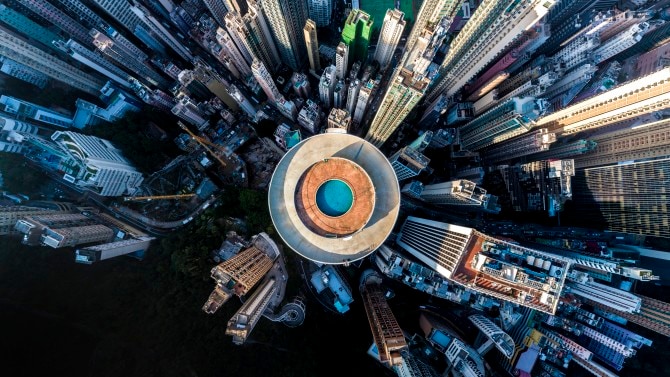Rozpatrując kluczowe trendy musimy pamiętać, że Displate to spółka nieco inna niż reszta. Jesteśmy spółką działającą tylko w e-commerce, operującą na 60 rynkach i sprzedającą głównie w USA i Europie Zachodniej. Do tego działamy w modelu D2C i obsługujemy kompleksowo zamówienia, od produkcji aż po obsługę posprzedażową. Tymczasem większość firm skupia się tylko na pewnym wycinku tego procesu, jednym, góra dwóch etapach.
Z tej perspektywy widzę trzy trendy makroekonomiczne, które silnie oddziaływują na funkcjonowanie szerzej pojętej branży handlowej, czyli retail i e-commerce. Pierwszy to trend, nazwijmy to, postcovidowy. W wyniku pandemii część użytkowników przeniosła się do sieci. Handel stacjonarny nie działał, ludzie zaczęli kupować online. W USA sektor e-commerce urósł w 2020 roku o 32 proc. To przejście do internetu trwale zmieniło zwyczaje konsumenckie, również w czasach po pierwszej i drugiej fali pandemii.
Wzrosty rynku e-commerce powróciły do dynamiki sprzed pandemii, ale powstał efekt nowej, wyższej bazy. Gdy handel stacjonarny nie funkcjonował, wiele spółek działających w handlu tradycyjnym, mam tu na myśli korporacje i duże firmy retailowe, przeniosło swoją uwagę i budżety do świata online. Firmy, który nie posiadały struktur, kompetencji i procesów niezbędnych do funkcjonowania w tym świecie, ubytki zasypywały pieniędzmi. Praktyka wygląda tak, że przy odpowiednio dużym budżecie nie ma takiej dziury, jakiej nie dało by się pieniędzmi zasypać. Widać to wyraźnie na przykładzie walki o talenty na rynku pracy, albo w kosztach reklamy online. Zwykle dynamika wzrostu budżetów na ten cel nie przekraczała znacząco 10 proc. rok do roku. Teraz mamy do czynienia ze wzrostami rzędu 20 proc. W przypadku firm kupujących reklamy w modelach aukcyjnych te wzrosty na niektórych rynkach i targetach przekroczyły 50 proc. Czyli firmy bardziej agresywnie się licytują i mamy większą konkurencję.
Zresztą wzrost cen nie dotyczy tylko reklamy w modelu CPA czy CPC. Mamy do czynienia z ogólnym, silnym trendem inflacyjnym. I o ile przez ostatnie lata ta inflacja była niska ze względu na wiele czynników ograniczających koszty, w ciągu ostatniego roku koszty w różnych kategoriach mocno poszybowały w górę. Wzrosły wynagrodzenia, co wiąże się ze wspomnianą walką o talenty, znacznie wzrosły koszty transportu, zwłaszcza frachtu. To jest o tyle istotne, że zwykle jednostkowe koszty transportu morskiego stanowiły ułamek całkowitego kosztu transakcji. A w ciągu pół roku koszt kontenera na trasach międzykontynentalnych wzrósł dziesięciokrotnie. Nie wspominając o wzrostach cen surowców, energii, której koszty skutecznie podbijają ceny we wszystkich innych kategoriach wydatków. W styczniu tego roku PPI, czyli wskaźnik inflacji producenckiej, osiągnął poziom 26 proc.
Trzeci trend widać w strukturze wydatków konsumenckich. Przez wiele lat w portfelu klientów wysoki i stale rosnący udział stanowiły usług. COVID spowodował, że ten trend się gwałtownie odwrócił - miejsce usług zajęły towary. Powoli sytuacja wraca do normy, jednak pewne przyzwyczajenia zostaną z nami na dłużej. Mamy do czynienia z nowym punktem wyjścia i nie będzie powrotu do tego, co było. Tak samo, jak część konsumentów zaczęła kupować online i nie wróci już do handlu stacjonarnego, tak samo część wydatków konsumenckich będzie przeznaczona na towary, a nie usługi.

Mateusz Godala
CEO Displate
Podsumowując, mamy trzy wstrząsy: eksplozję konkurencji, eksplozję inflacji i zmianę zachowań konsumentów. To powoduje, że w średnioterminowej perspektywie pojawią się dwa zjawiska.
Duża część firm, uprzednio działających na niskich marżach, nie może ich podnieść. Przyczyny mogą być różne, często jest to brak optymalizacji wydatków. Dotychczas sytuacja na rynku nie zmuszała do takiej optymalizacji. Dostęp do pieniądza był łatwy, kredyty były niemal darmowe i można było je rolować prawie w nieskończoność. To eldorado się kończy, stopy procentowe wzrastają, koszty kredytów również. Zdolności kredytowe firm i konsumentów spadają.
Więc jeśli takie firmy przyzwyczajone do taniego pieniądza podniosą marże, stracą konsumentów, którzy odejdą do lepiej zoptymalizowanej kosztowo konkurencji. A ze względu na wyższe koszty kredytów niekoniecznie będą miały skąd brać nowe środki. W średnim terminie duża część firm nie przeżyje takich warunków i będzie musiała albo ograniczyć działalność, albo po prostu zniknie z rynku.
Jeśli mówimy o firmach, które zostaną dotknięte przez zmiany tak bardzo, że nie będą w stanie pozyskiwać nowych klientów, to one będą zwracać się ku platformom, takim jak Amazon, Allegro i tym podobne. I to widać już teraz. Kiedy pojawiła się pandemia, największą część tortu zgarnęli duzi gracze. A w czasach po pandemii ten, kogo nie stać na akwizycję, przejdzie do tych dużych graczy, którzy są w stanie ją zapewnić. I te duże platformy znów nieproporcjonalnie dużo zyskają.
Jeśli mówimy o firmach, które zostaną dotknięte przez zmiany tak bardzo, że nie będą w stanie pozyskiwać nowych klientów, to one będą zwracać się ku platformom, takim jak Amazon, Allegro i tym podobne.
Kolejny średnioterminowy trend to kompetencje związane z wykorzystaniem first-party data. Na rynku zachodzą zmiany wynikające z podejścia konsumentów, coraz mniej skłonnych do dzielenia się informacjami o sobie i swojej aktywności, przez co first-party data będą coraz bardziej pożądanym towarem. A to właśnie te dane przyczyniły się do eksplozji życia w sieci, dzięki temu powstały wszelkiej maści start-upy, małe i większe biznesy e-commerce, SaaS i tym podobne. To się niestety będzie kończyć, bo kurek z danymi z pierwszej ręki będzie coraz bardziej dokręcany. Oczywiście branża e-commerce dalej będzie mogła korzystać z third-party data. Jednak to już nie to samo, korzystanie z takich danych nie jest dla firmy tak efektywne i stanowi rodzaj ograniczenia. Firmy, które będą w stanie zbierać first-party data, budować i monetyzować bazy i używać je na swój pożytek, będą wygranymi. Ale to nie będą te firmy, które korzystają ze wspomnianych platform e-commerce, bo platformy wycinają dostęp do swoich danych z pierwszej ręki. Te dane to surowiec cenny niczym ropa naftowa. A dane zbierane przez platformy można przyrównać do całego ogromnego pola naftowego. I nie dziwne, że nie chcą się tym dzielić z innymi.
Poza tym, abstrahując już od samych trendów, produkty mają swój naturalny cykl życia, związany ze wzrostem i pojawianiem się mniejszej, bardziej elastycznej konkurencji. Platformy najpierw oferują pojedyncze usługi, a następnie łączą je w pakiety, optymalizując ofertę. Tak było na przykład z kablówką. W pewnym momencie pojawił się Netflix z prostym pomysłem - zamiast sześciu kablówek możecie mieć jedną usługę - i wygrał wszystko.To była faza tzw. bundlingu. Teraz na rynku VOD mamy unbundling, powstaje masa nowych usług, bazujących na tej samej koncepcji co Netflix. Ale za kilka lat pojawi się gracz, który powie: jednym abonamentem ogram wam dostęp do Netfliksa, Disney+ i czego jeszcze dusza zapragnie. I wtedy znów ten rynek przejdzie do fazy bundlingu. Aktualnie na różnych rynkach następuje naturalnie albo jedna albo druga faza. W pewnym momencie rynek staje się tak zdefragmentowany, że gracz, który jest w stanie go scentralizować, tworząc platformę, osiąga przewagę konkurencyjną. Z czasem staje się zbyt duży i pojawiają się małe piranie, które go podgryzają - bo są efektywniejsze w poszczególnych obszarach biznesowych, w których ten wspomniany kolos funkcjonuje.
Kolejny średnioterminowy trend to kompetencje związane z wykorzystaniem first-party data.
Wyzwania branży w okresie pandemii
Można wyodrębnić dwa etapy w ciągu ostatnich dwóch lat. Pierwszy to początek pandemii, który był dość przerażający dla biznesu - mieliśmy perspektywę kryzysu gospodarczego, spadające w szalony sposób z tygodnia na tydzień przychody, ogólną panikę na rynku. Ten stan na szczęście utrzymywał się krótko, około dwóch tygodni, maksymalnie miesiąc. A później okazało się, że można zrobić niezły biznes. Nie ma tego złego, co by na dobre nie wyszło - ten pierwszy etap był dobry dla nas pod wieloma względami.
W Displate mieliśmy wszystko pod kontrolą i mogliśmy szybko reagować w kwestii produktu, logistyki, promocji itd. Dzięki temu po tej wstępnej fazie szoku przeszliśmy do fazy gwałtownego wzrostu. Do tego mieliśmy już wcześniej zbudowane silne kompetencje w dziedzinie płatnego marketingu. Dzięki temu, gdy inni wycofywali się z rynku lub próbowali dostosować się do panującej sytuacji i przegrupować się, my wrzuciliśmy szybko najwyższy bieg i w rok zrobiliśmy 300 proc. wzrostu. Przez pierwsze pół roku było dużo wolnej przestrzeni rynkowej i postanowiliśmy to w pełni wykorzystać, gospodarując konsumentów, o których akurat nikt nie konkuruje.
Etap postcovidowy to etap optymalizacyjny. W warunkach, w których rosną koszty wszystkiego, nie chcemy być spółką, której to zagrozi. Dlatego to okres, w którym pogodziliśmy się ze zwolnieniem dynamiki wzrostu, ale dzięki temu mogliśmy skupić się na optymalizacji kosztów. W skali mikro oznacza to, że skupiliśmy się bardziej na kwestiach takich jak lifetime value oraz powracalności i lojalności klientów. Teraz przyszedł czas na budowanie brandu i ruchu organicznego, co na dłuższą metę obniża koszt kontaktu z klientem i przyzwyczaja go do marki. Czyli odeszliśmy od tego typowego dla e-commerce ciągu technologicznego - reklama, promocja, targeting, konwersja, myk i gotowe. Zamiast tego budujemy lojalność dzięki częstszym kontaktom z marką, a te kontakty mają być dla użytkownika przyjemne i pożyteczne, bez ciśnięcia na szybką konwersję.
Etap postcovidowy to etap optymalizacyjny. W warunkach, w których rosną koszty wszystkiego, nie chcemy być spółką, której to zagrozi.
Budowa i utrzymanie relacji z klientami
W obecnych realiach ważne jest to, aby być w kontakcie z klientem. I działać z wyczuciem. Ale poza tym trzeba pamiętać o jeszcze jednym. Umiejętności wczucia się w sytuację usera, polubieniu go i umiejętności wejścia w jego buty. W Bolcie każdy pracownik biurowy, niezależnie od szczebla, musi raz w miesiącu usiąść za kierownicą jako kierowca Bolta. Dzięki temu ma kontakt, w jak najbardziej dosłownym znaczeniu, z użytkownikami swojej aplikacji.
Sam lubię wiedzieć, co klienci piszą i mówią o nas, sam też korzystam z usług własnej firmy. Ten wywiad zapewne przeczytają też ludzie z Displate, ale trudno, przyznam się. Bo wysyłam też do nas na zakupy znajomych, żeby sprawdzili jakość obsługi.
Rozważając dostosowywanie się szeroko pojętej branży retail do zachowań klientów podczas pandemii prawdopodobnie największym trendem będzie chęć posiadania rzeczy w domu, tu i teraz. I funkcjonowanie w kanałach, które zapewniają logistykę i dostawy, na przykład Allegro Smart. Ludzie chcą mieć rzeczy dostarczone na już, tak że nie muszą po nie nigdzie jeździć. Czyli mieć je w domu albo przynajmniej w stojącym pod ich domem paczkomacie.
Część zmian, które pojawiły się podczas pandemii cofnęła się, część jest nieodwracalna. Ludzie częściej pracują z domu, wspomniałem już o udziale towarów i produktów w portfelu, który nie cofnie się do poprzedniego, przedpandemicznego poziomu. Rynek e-commerce będzie bardziej międzynarodowy. Ludzie coraz chętniej szukają produktów, wychodząc poza swój macierzysty rynek. I są platformy, które te bezpieczne, międzynarodowe zakupy umożliwiają.
Trendy technologiczne wspierające procesy wewnętrzne w firmie
Najbardziej rzucający się w oczy trend to praca zdalna i hybrydowa. Myślę, że zostanie z nami na stałe, managerowie będą musieli przemyśleć, jak działać efektywnie i jak ten tryb przyswoić. Czy dla firm będzie ok, że kogoś nie ma w ciągu dnia w pracy i pracuje wieczorem, czy powinniśmy może siedzieć od 8 do 16?
Biura staną się bardziej międzynarodowe i elastyczne, bo w walce o talenty firmy zatrudniają tam, gdzie się da. Niestety w tej sytuacji niektóre polskie firmy będą stratne, bo część specjalistów z Polski bez problemu znajdzie pracę w zachodnich firmach po dużo lepszych stawkach niż to, co mogą dostać w kraju. Co do pozostałych kwestii nie spodziewałbym się rewolucji.
Rozważając dostosowywanie się szeroko pojętej branży retail do zachowań klientów podczas pandemii prawdopodobnie największym trendem będzie chęć posiadania rzeczy w domu, tu i teraz.




